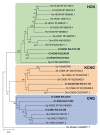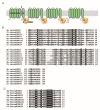The Roles of Two CNG Channels in the Regulation of Ascidian Sperm Chemotaxis
- PMID: 35163568
- PMCID: PMC8835908
- DOI: 10.3390/ijms23031648
The Roles of Two CNG Channels in the Regulation of Ascidian Sperm Chemotaxis
Abstract
Spermatozoa sense and respond to their environmental signals to ensure fertilization success. Reception and transduction of signals are reflected rapidly in sperm flagellar waveforms and swimming behavior. In the ascidian Ciona intestinalis (type A; also called C. robusta), an egg-derived sulfated steroid called SAAF (sperm activating and attracting factor), induces both sperm motility activation and chemotaxis. Two types of CNG (cyclic nucleotide-gated) channels, Ci-tetra KCNG (tetrameric, cyclic nucleotide-gated, K+-selective) and Ci-HCN (hyperpolarization-activated and cyclic nucleotide-gated), are highly expressed in Ciona testis from the comprehensive gene expression analysis. To elucidate the sperm signaling pathway to regulate flagellar motility, we focus on the role of CNG channels. In this study, the immunochemical analysis revealed that both CNG channels are expressed in Ciona sperm and localized to sperm flagella. Sperm motility analysis and Ca2+ imaging during chemotaxis showed that CNG channel inhibition affected the changes in flagellar waveforms and Ca2+ efflux needed for the chemotactic turn. These results suggest that CNG channels in Ciona sperm play a vital role in regulating sperm motility and intracellular Ca2+ regulation during chemotaxis.
Keywords: cAMP; cGMP; calcium; fertilization; sperm chemotaxis.
Conflict of interest statement
The authors declare no conflict of interest.
Figures







Similar articles
-
The Role of Soluble Adenylyl Cyclase in the Regulation of Flagellar Motility in Ascidian Sperm.Biomolecules. 2023 Oct 30;13(11):1594. doi: 10.3390/biom13111594. Biomolecules. 2023. PMID: 38002275 Free PMC article.
-
Store-operated calcium channel regulates the chemotactic behavior of ascidian sperm.Proc Natl Acad Sci U S A. 2003 Jan 7;100(1):149-54. doi: 10.1073/pnas.0135565100. Epub 2002 Dec 23. Proc Natl Acad Sci U S A. 2003. PMID: 12518063 Free PMC article.
-
Lipid rafts function in Ca2+ signaling responsible for activation of sperm motility and chemotaxis in the ascidian Ciona intestinalis.Mol Reprod Dev. 2011 Dec;78(12):920-9. doi: 10.1002/mrd.21382. Epub 2011 Sep 1. Mol Reprod Dev. 2011. PMID: 21887722
-
[Cyclic nucleotide-gated channels and sperm function].Zhonghua Nan Ke Xue. 2013 Mar;19(3):270-3. Zhonghua Nan Ke Xue. 2013. PMID: 23700737 Review. Chinese.
-
Retinal Cyclic Nucleotide-Gated Channels: From Pathophysiology to Therapy.Int J Mol Sci. 2018 Mar 7;19(3):749. doi: 10.3390/ijms19030749. Int J Mol Sci. 2018. PMID: 29518895 Free PMC article. Review.
Cited by
-
The Mature COC Promotes the Ampullary NPPC Required for Sperm Release from Porcine Oviduct Cells.Int J Mol Sci. 2023 Feb 4;24(4):3118. doi: 10.3390/ijms24043118. Int J Mol Sci. 2023. PMID: 36834527 Free PMC article.
-
N-Formyl-L-aspartate mediates chemotaxis in sperm via the beta-2-adrenergic receptor.Front Cell Dev Biol. 2022 Sep 23;10:959094. doi: 10.3389/fcell.2022.959094. eCollection 2022. Front Cell Dev Biol. 2022. PMID: 36211455 Free PMC article.
-
The Role of Soluble Adenylyl Cyclase in the Regulation of Flagellar Motility in Ascidian Sperm.Biomolecules. 2023 Oct 30;13(11):1594. doi: 10.3390/biom13111594. Biomolecules. 2023. PMID: 38002275 Free PMC article.
-
Molecular mechanisms of mammalian sperm capacitation, and its regulation by sodium-dependent secondary active transporters.Reprod Med Biol. 2024 Oct 16;23(1):e12614. doi: 10.1002/rmb2.12614. eCollection 2024 Jan-Dec. Reprod Med Biol. 2024. PMID: 39416520 Free PMC article. Review.
References
MeSH terms
Substances
Grants and funding
LinkOut - more resources
Full Text Sources
Research Materials
Miscellaneous

